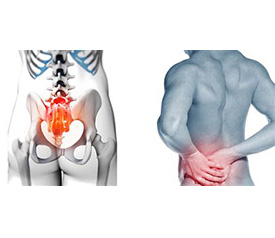
Dysfunction in the sacroiliac joint (SIJ) which is a large joint in your lower back connecting your sacrum to your pelvis, can sometimes cause lower back and/or leg pain. Dysfunction of this joint basically means that it is not operating normally.
For decades, the sacroiliac joint was suspected as a common cause of low back and/or leg pain, although difficulty in accurate diagnostic testing has made this difficult to substantiate. Today it is estimated that the SIJ is responsible for 15% to 30% of lower back pain cases.
The primary mechanisms of SIJ dysfunction include:
- Too much movement in the SIJ can cause the pelvis to feel unstable and lead to pain. Pain from too much motion is typically felt in the lower back and/or hip and may radiate into the groin area.
- Not enough movement can cause muscle tension, pain, and may inhibit mobility. Pain is typically felt on one side of the low back or buttocks and can radiate down the back of the leg like sciatica pain.
SIJ dysfunction is more common in young and middle-aged women. Women who are pregnant or have recently given birth may be more susceptible to SIJ pain.
Chiropractic treatment for SIJ dysfunction typically focus on alleviating pain and restoring normal motion in the joint. Most cases of SI joint pain are effectively managed using Chiropractic care without the need for a referral for more tests.
Initial treatment for SIJ pain dysfunction includes:
- Brief rest period. A rest period of 1 to 2 days may be advised. Resting for longer than a couple days is not recommended, as doing so may worsen stiffness and cause increased pain and generalized weakness.
- Applying ice or heat. Ice applied to the low back and pelvis can reduce inflammation and alleviate pain and discomfort. Later on, heat applied around the joint may help relieve pain by reducing muscle tension or spasms.
- Manual manipulation. Manual manipulation provided can be highly effective if sacroiliac joint pain is caused by too little movement. This consists of physical adjustments applied to the SI joint, and lower back region with the goal of restoring normal movement in the joints.
- Supports or braces. When the SI joint is not moving enough, a pelvic brace can be wrapped around the waist and pulled snugly to stabilize the area. A pelvic brace is about the size of a wide belt and can be helpful when the joint is inflamed and painful.
There is no single approach to managing SI joint pain that will work for everyone. A combination of treatment as determined by your Chiropractor is usually necessary for effective pain relief.
Stretch of the Month
Tricep Stretch

- Stand straight up with your legs shoulder width apart
- Bend your left arm at the elbow and touch the top of your shoulder blade with your fingers
- Reach over the top of your head with your left arm and grasp your right elbow
- Gently pull with you right arm to increase the tension on the tricep muscle
- Hold for 20-30 seconds
- Repeat on your other arm
Towards Wellness
Eating the Right Types of Fat
Many people don’t eat enough of the right types of fat.

Add healthy natural fats to your diet such as extra virgin olive oil, macadamia nut oil, coconut oil, avocados, nuts, seeds and even butter. Fat is satiating and helps to prevent overeating. Fat also improves nutrient absorption from vegetables.

